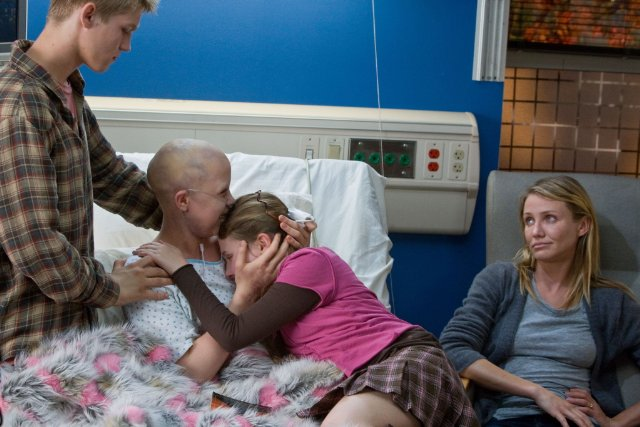I saw this great film; it was about a girl who...
Admittedly, when we describe a film, we often talk about one central character, usually the character with a weakness that goes on a journey and changes, often called the protagonist. But is the protagonist the only important character? Perhaps the protagonist is the most central character in terms of conflict and theme, but I think it’s better to consider all characters as equally important, something I’ve been able to do better when using Roger Stennett’s five story development questions, which I look at below with examples from the film, My Sister’s Keeper.
Spoilers below.
1. What do I want to say?
As I mentioned in my Down on the Farm post, you’ve really got to have a passion for the story you are telling and have a strong message to express. I can imagine that Jodi Picoult, who wrote the original Novel of My Sister’s Keeper, had a strong sense of what the story was all about.
For those who don’t know, My Sister’s Keeper is all about Anna, who’s engineered cells and tissues are saving her older sister Kate’s life from Leukaemia, who sues her family for the rights to her own body. There are lots of moral questions, but mainly it’s about the mother, Sara, the protagonist, who fights to keep Kate alive, damaging her family and sometimes even preventing Kate from positive life experiences, whilst Anna sues not just for the rights to her body, but for Kate’s right to die. The film asks how far we are willing to go to save a loved one; is it right to put the needs of everyone else, including the one we are protecting, second to our need to keep them alive? What I think is wonderful, is how there are no easy solutions, and finally Sara is forced to let Kate go, giving her what she wants, celebrating the good life she’s lived, and finally bringing her family together.
2. Who are these people?
This question seems to ask about a community, and unless your character is a hermit (but then consider how the community feels about that hermit) they have people in their lives with values. How to Train Your Dragon features a community of tough Viking dragon slayers, and The Firm a community of highflying, intrusive businessmen. My Sister’s Keeper is all about the family unit, and each one is dealing with the care of Kate whilst trying to keep their family together, and it’s through how they go about this that the story and theme unfolds.
3. What do they want?
Sara wants to keep Kate alive and well, whereas Anna wants to sue her parents for the rights to her own body, until it’s then revealed she, along with her brother Jesse, wants to help Kate to die. Brian, Sara’s husband initially helps with Kate’s treatment, but then he discharges Kate to take her to the beach against Sara’s wishes, showing his allegiance to Anna and Jesse.
Everyone wants something and side under two distinct moral points of view, to let Kate live or die, but overall everyone wants to keep their family together and each go separate ways to achieve it.
4. What stops them getting it?
The film is based upon the idea that Sara would never allow Kate to die, and Anna has to get the rights to her body to make that decision. We have the scenes in the court room involving Campbell, Anna’s lawyer, and Judge De Salvo, who is dealing with her own grief. I love how the family are all in opposition, but still sit around the dinner table together, attempting to function as best they can as a normal family despite the conflicts bubbling under the surface.
5. Why should I care?
This is hard question to answer. “It’s my story, of course you should care!” I think it’s about the stakes of the film, what happens if the characters should fail. If Anna doesn’t get the rights to her body she will have to undergo several operations. It’s horrible to think that a child should have to do that, and we care because there is something moral going on here and a person could get hurt.
I also think we care when we empathise with the situation. We don’t like Sara for doing what she’s doing to Anna, but we understand the lengths a mother would go to save her daughter. If a character does something morally wrong yet we get why they are doing it, I think we are gripped. We start to question the way we view the world. What is right or wrong? That’s what a great film or story is supposed to do. Make use reassess the way we view the world, and come out feeling changed ourselves. That’s why we should care, because this film is saying something important.
I thought I’d wrap up with my inspiration to this post. I read an article describing the primary character and secondary characters, with a warning not to reveal too many surprises about the secondary characters as this might distract from the primary character. Although I do agree that we don’t want to dilute the film too much or else it could lose its focus on the protagonist’s journey, we, as writers shouldn’t think in a black and white sense of primary and secondary. All the character’s in My Sister’s Keeper serve the change in Sara’s character through added texture and colour. Even if certain aspects of character don’t make the final cut, it’s good to know all your characters inside out, and to remember that all characters are central to the story with their own unique purpose.
You can read more about screenwriter, dramatist and director Roger Stennett, on his website

No comments:
Post a Comment